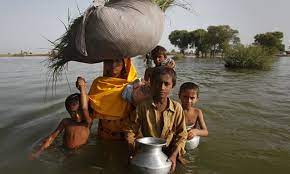The International Monetary Fund (IMF) has revealed in its recent report that Pakistan is among the most vulnerable countries to climate change which has been causing a $ 2 billion loss annually to the South Asian nation since 2000. As said, climate change affects four million people every year, while last year’s superfloods impacted 30 million people and perished 1,700 lives causing the bulk of economic losses, and displacement. The report highlighted that Pakistan’s economy may be affected by natural disasters by up to 9% by the year 2050. The IMF has also raised concerns about the affordability of Pakistan’s Public Sector Development Programme (PSDP), urging a reassessment of the initiative concerning budget allocation and the volume of the impending risk to basic infrastructure in the country. The report emphasized the importance of climate-resilient infrastructure, given Pakistan’s exposure to climate risks. The IMF emphasized the incomplete implementation of measures outlined in the Public Financial Management Act 2019 and the 2021 Manual for Development Projects.
Pakistan is highly vulnerable to global warming and natural disasters because of its geographical location, topography, acute weather conditions, irregular growth and untidy governance. Historically, Climate change has had significant impacts on Pakistan, particularly in the form of extreme weather events, water scarcity, glacial melt, and periodic heatwaves in the country. The Country faces severe challenges such as agricultural productivity, increased flooding, droughts, and water and food insecurity that merit urgent attention from the leaders to avert the bulk of economic, monetary, and administrative challenges until they physically threaten the nation in the future. Historically, our nation has been facing climate-induced weather events regularly including earthquakes, floods, landslides, cyclones, etc. that caused significant damage to the country’s infrastructure, economy, and population. Presently, global warming has caused serious survival risks for the South Asian nation, as last year’s superfloods caused nearly $30 billion in economic losses, while monsoon floods have become a recurrent phenomenon on an annual basis.
The primary purpose of the Pakistan Public Sector Development Program (PSDP) is to plan, finance, and execute development projects aimed at improving infrastructure, education, healthcare, energy, transportation, and other sectors essential for the nation’s progress. The PSDP is crucial for implementing the government’s development agenda, allocating budgets, and monitoring the progress of projects across different ministries and departments. Its role involves prioritizing projects, allocating funds, ensuring transparency and efficiency in project execution, and facilitating socio-economic growth and progress in the country. The IMF report has categorically mentioned the flaws and anomalies in PSDP’s projects planning, funds allocation as well and time for execution and completion of the projects which often lead to delays, an increase in cost, reevaluation of the projects that mostly end up in additional financial burden/ incompletion or downsizing of the projects.
Historically, global think tanks, international financial institutions, and scholarly circles have always provided constructive input to Pakistan regarding its policies relating to governance, financial management, monitoring, and regulation to curb corruption, misuse of resources and enhance transparency in government spending yet Pakistani strategists often reject those suggestions terming them inapplicable in Asian or Pakistan’s peculiar environment. After all, politically motivated policies and projects often prove to be counterproductive and disastrous for our nation. It is high time that the planning commission and provinces revisit their PSDP projects and remove their flaws to build and protect their nation from the worst effects of global warming, which is a need of the hour and demand of nationalism.







